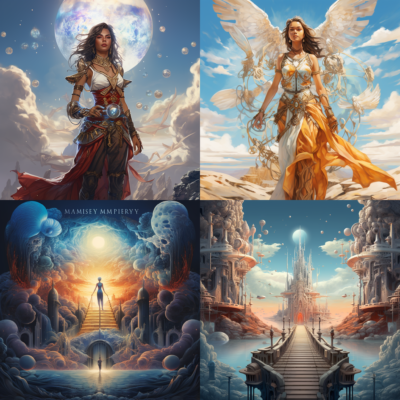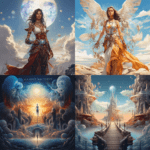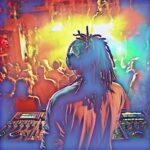AI
The AI Art Revolution: Unleashing Creativity with Technology
Welcome to the mesmerizing universe of AI-generated art, where the fusion of creativity and technology is redefining the way we express and appreciate art. In this dynamic landscape, ground-breaking tools like DALL-E 3, Midjourney, and Leonardo.ai are at the forefront, ushering in a new era of artistic exploration.
DALL-E 3: Crafting Realism Beyond Imagination
DALL-E 3, a titan in the AI art realm, was introduced by OpenAI in April 2022. Renowned for its ability to generate both realistic and imaginative images, it has left an indelible mark on the art community. While still in development, DALL-E 3 has been a powerhouse, producing a diverse array of art, from classical paintings to futuristic sculptures and captivating photography.

At OpenAI DevDay 2023, a series of ground-breaking updates were unveiled, elevating DALL-E 3’s capabilities to unprecedented heights. With features like a 128k context window, knowledge of world events up to April 2023, custom GPTs, and the Assistants API, DALL-E 3 is not just an art generator; it’s a gateway to a new realm of artistic possibilities.
Midjourney: Navigating Dreams and Realities
Enter the dreamlike world of Midjourney, a prominent player in the AI art scene since its release in 2021. Renowned for its ability to conjure surreal and dreamlike images, Midjourney has left an indelible mark on various art forms, including paintings, sculptures, and even influencing fashion designs.



Recent updates have only enhanced Midjourney’s allure, introducing a Style Tuner for fine-tuning image styles, improved image quality, faster generation times, and a collection of creative prompts designed to ignite the spark of inspiration.
Leonardo.ai: Crafting Versatility in Every Pixel
Stepping onto the stage in 2023, Leonardo.ai has quickly gained recognition for its prowess in generating high-quality images across a broad spectrum of styles, from classical to contemporary.



Recent updates, including Alchemy v2 for combining multiple images, improved image generation, increased image size capabilities, and a suite of new image editing features, have elevated Leonardo.ai to new heights of creativity.
Other Noteworthy AI Art Generators
Beyond the spotlight, several other generators contribute to the artistic landscape:
Artbreeder: A tool allowing users to morph existing images into novel creations.
Dream by WOMBO: Allowing users to conjure surreal and dreamlike images through text prompts or pre-set selections.
Harnessing the Power of AI Art Generators
The versatility of AI art generators extends far beyond mere entertainment, finding application in various realms:
Personal Enjoyment: Create personalized art for home décor, gifts, or simply revel in the joy of artistic expression.
Business Creativity: Generate assets for marketing materials, product packaging, and website designs.
Conceptual Art: Fuel the creation of concept art for video games, movies, and other creative projects.
Artistic Exploration: Push the boundaries of artistic expression, exploring uncharted territories with AI assistance.
The Future Canvas: A Tapestry of Possibilities
The journey of AI art generators is still in its infancy, yet the trajectory points towards a transformative future. As these tools become more sophisticated and accessible, they hold the promise of democratizing art creation, making it a universal language.
The Ethical Tapestry: Weaving Responsibility into Creativity
Amidst the excitement, ethical considerations loom large. Responsible use of AI art is imperative to ensure it respects the rights of artists and avoids generating harmful or offensive content. Open dialogue about these concerns will pave the way for a harmonious integration of AI art into our creative landscape.
Conclusion: Brushstrokes of Tomorrow
The AI art generator scene paints a captivating narrative of innovation and limitless potential. Already shaping diverse forms of art, from the traditional to the avant-garde, these tools are set to redefine the artistic landscape. As we navigate this dynamic canvas, it’s essential to celebrate the creative surge while mindful of ethical responsibilities.
Welcome to the mesmerizing universe of AI-generated art, where the fusion of creativity and technology is redefining the way we express and appreciate art. In this dynamic landscape, ground-breaking tools like DALL-E 3, Midjourney, and Leonardo.ai are at the forefront, ushering in a new era of artistic exploration.
DALL-E 3: Crafting Realism Beyond Imagination
DALL-E 3, a titan in the AI art realm, was introduced by OpenAI in April 2022. Renowned for its ability to generate both realistic and imaginative images, it has left an indelible mark on the art community. While still in development, DALL-E 3 has been a powerhouse, producing a diverse array of art, from classical paintings to futuristic sculptures and captivating photography.



At OpenAI DevDay 2023, a series of ground-breaking updates were unveiled, elevating DALL-E 3’s capabilities to unprecedented heights. With features like a 128k context window, knowledge of world events up to April 2023, custom GPTs, and the Assistants API, DALL-E 3 is not just an art generator; it’s a gateway to a new realm of artistic possibilities.
Midjourney: Navigating Dreams and Realities
Enter the dreamlike world of Midjourney, a prominent player in the AI art scene since its release in 2021. Renowned for its ability to conjure surreal and dreamlike images, Midjourney has left an indelible mark on various art forms, including paintings, sculptures, and even influencing fashion designs.



Recent updates have only enhanced Midjourney’s allure, introducing a Style Tuner for fine-tuning image styles, improved image quality, faster generation times, and a collection of creative prompts designed to ignite the spark of inspiration.
Leonardo.ai: Crafting Versatility in Every Pixel
Stepping onto the stage in 2023, Leonardo.ai has quickly gained recognition for its prowess in generating high-quality images across a broad spectrum of styles, from classical to contemporary.



Recent updates, including Alchemy v2 for combining multiple images, improved image generation, increased image size capabilities, and a suite of new image editing features, have elevated Leonardo.ai to new heights of creativity.
Other Noteworthy AI Art Generators
Beyond the spotlight, several other generators contribute to the artistic landscape:
Artbreeder: A tool allowing users to morph existing images into novel creations.
Dream by WOMBO: Allowing users to conjure surreal and dreamlike images through text prompts or pre-set selections.
Harnessing the Power of AI Art Generators
The versatility of AI art generators extends far beyond mere entertainment, finding application in various realms:
Personal Enjoyment: Create personalized art for home décor, gifts, or simply revel in the joy of artistic expression.
Business Creativity: Generate assets for marketing materials, product packaging, and website designs.
Conceptual Art: Fuel the creation of concept art for video games, movies, and other creative projects.
Artistic Exploration: Push the boundaries of artistic expression, exploring uncharted territories with AI assistance.
The Future Canvas: A Tapestry of Possibilities
The journey of AI art generators is still in its infancy, yet the trajectory points towards a transformative future. As these tools become more sophisticated and accessible, they hold the promise of democratizing art creation, making it a universal language.
The Ethical Tapestry: Weaving Responsibility into Creativity
Amidst the excitement, ethical considerations loom large. Responsible use of AI art is imperative to ensure it respects the rights of artists and avoids generating harmful or offensive content. Open dialogue about these concerns will pave the way for a harmonious integration of AI art into our creative landscape.
Conclusion: Brushstrokes of Tomorrow
The AI art generator scene paints a captivating narrative of innovation and limitless potential. Already shaping diverse forms of art, from the traditional to the avant-garde, these tools are set to redefine the artistic landscape. As we navigate this dynamic canvas, it’s essential to celebrate the creative surge while mindful of ethical responsibilities.
AI Art: Unleashing Creative Potential in Media and Marketing
Welcome to the fascinating realm of AI-driven creativity! In recent years, artificial intelligence has ventured into uncharted territory within the world of art, dazzling audiences with its innovative and imaginative creations. From paintings to poetry, music to movies, AI is reshaping the landscape of creativity. In this article, we will explore the captivating world of AI’s boundless creativity, revealing how it is pushing boundaries and unfurling a vibrant spectrum of possibilities.
AI: Redefining the Boundaries of Creativity
Art has always been synonymous with human imagination and ingenuity. However, the emergence of artificial intelligence is broadening our perception of creativity. AI systems have been trained to analyse vast data sets, recognize patterns, and generate entirely new and original works of art. This has opened up an entirely new realm of creativity, where machines collaborate with human artists or independently craft art.
One of the most remarkable aspects of AI’s creative prowess is its ability to think beyond conventional limits. By processing enormous volumes of data, AI can identify connections and patterns that may elude human artists. This unique capacity allows AI to generate innovative and thought-provoking concepts that challenge the traditional boundaries of artistic expression. The fusion of human imagination and AI’s computational power is giving rise to a stunning array of artistic masterpieces that captivate audiences worldwide.



AI’s Expansive Influence on the Art World
AI’s influence extends far beyond traditional artistic mediums such as painting and sculpture. AI systems are also revolutionizing how we engage with and experience art. Through virtual reality and augmented reality, AI is creating immersive and interactive art installations that transport viewers into captivating digital realms. By combining AI’s computational abilities with cutting-edge technologies, artists can craft multisensory experiences that blur the line between the physical and the virtual world.
Furthermore, AI is not confined to the visual arts alone. It ventures into music composition, literature, and even filmmaking. With AI algorithms proficient in analysing vast data sets, they can compose symphonies, write novels, and even generate movie scripts. The result is a diverse tapestry of AI-generated art that challenges our conventional views of creativity and stretches the boundaries of human imagination.
As AI continues to evolve, its creative potential expands in parallel. The synergy between human artists and AI systems is charting new frontiers in artistic expression, inspiring awe and wonder in audiences across the globe. While some may raise questions about the authenticity or originality of AI-created art, there is no denying the sheer beauty and innovation stemming from this collaboration. As we step into the future, let us embrace AI’s boundless creativity, painting a world where imagination knows no limits.



AI Art in Media: A Creative Revolution
Artificial intelligence’s impact on the media industry is nothing short of revolutionary. It has the ability to transform content creation, distribution, and engagement. Here are some key areas where AI art is reshaping the media landscape:
- Content Generation: AI algorithms can create visual content, such as images and videos, tailored to the needs of media outlets. This automation allows for faster content production, which is especially valuable in the fast-paced world of news and digital media.
- Personalization: AI-powered recommendation systems use art to enhance user experience. These systems analyse user preferences and behaviours to deliver personalized content, including articles, images, and videos. This keeps audiences engaged and coming back for more.
- Visual Storytelling: Media is not just about facts and figures; it’s also about telling a compelling story. AI-generated art can enhance storytelling by providing visually stunning graphics, infographics, and animations that captivate audiences and convey complex information in an accessible manner.
- Virtual Reality Journalism: AI’s ability to generate immersive environments and 3D visuals has given rise to virtual reality (VR) journalism. Reporters can use AI-generated visuals to create virtual news experiences, allowing audiences to step into the heart of the story.
- Efficient Post-Production: In the realm of film and video production, AI can assist in the post-production process by generating special effects, enhancing visuals, and even suggesting creative edits. This not only saves time but also expands the creative possibilities for filmmakers.
- Dynamic Advertising: AI art is a game-changer for dynamic advertising. Advertisers can use AI to generate personalized ad visuals in real-time based on user data. This makes ads more relevant and engaging, increasing the chances of conversion.



AI Art in Marketing: Elevating Branding and Engagement
AI-driven art is also leaving its mark on the marketing world, offering new avenues for branding and audience engagement:
- Visual Branding: Your brand’s visual identity is crucial, and AI can assist in creating and maintaining a consistent visual style across all marketing materials. This includes logo design, colour schemes, and even AI-generated mascots.
- Content Creation: AI-driven art can assist in generating content for social media, websites, and email marketing. Marketers can use AI to create eye-catching visuals, infographics, and videos that resonate with their target audience.
- Predictive Analytics: AI can analyse consumer data and behaviour to predict trends and preferences. Marketers can use these insights to create art and content that resonates with their audience, ultimately leading to more effective marketing campaigns.
- Chatbots and Virtual Assistants: AI-powered chatbots often come with visual avatars. These avatars, often created using AI-generated art, make interactions more engaging and personable.
- Email Marketing: Visual elements, including AI-generated art, can significantly impact email marketing. From personalized product recommendations to engaging email headers, AI can boost open and click-through rates.
- AR Advertising: Augmented reality (AR) advertising is on the rise. AI-generated AR art can enhance user engagement by allowing customers to interact with products or experiences in a virtual space before making a purchase.



AI art is revolutionizing the media and marketing industries. Its ability to generate content, personalize experiences, enhance storytelling, and engage audiences is transforming the way we consume and interact with media and how brands connect with their customers. As AI continues to evolve, its creative potential in these domains will undoubtedly expand, offering exciting possibilities for the future. This synergy of technology and art is reshaping the way we perceive and experience the world around us, making it a fascinating journey to follow.
Welcome to the fascinating realm of AI-driven creativity! In recent years, artificial intelligence has ventured into uncharted territory within the world of art, dazzling audiences with its innovative and imaginative creations. From paintings to poetry, music to movies, AI is reshaping the landscape of creativity. In this article, we will explore the captivating world of AI’s boundless creativity, revealing how it is pushing boundaries and unfurling a vibrant spectrum of possibilities.
AI: Redefining the Boundaries of Creativity
Art has always been synonymous with human imagination and ingenuity. However, the emergence of artificial intelligence is broadening our perception of creativity. AI systems have been trained to analyse vast data sets, recognize patterns, and generate entirely new and original works of art. This has opened up an entirely new realm of creativity, where machines collaborate with human artists or independently craft art.
One of the most remarkable aspects of AI’s creative prowess is its ability to think beyond conventional limits. By processing enormous volumes of data, AI can identify connections and patterns that may elude human artists. This unique capacity allows AI to generate innovative and thought-provoking concepts that challenge the traditional boundaries of artistic expression. The fusion of human imagination and AI’s computational power is giving rise to a stunning array of artistic masterpieces that captivate audiences worldwide.



AI’s Expansive Influence on the Art World
AI’s influence extends far beyond traditional artistic mediums such as painting and sculpture. AI systems are also revolutionizing how we engage with and experience art. Through virtual reality and augmented reality, AI is creating immersive and interactive art installations that transport viewers into captivating digital realms. By combining AI’s computational abilities with cutting-edge technologies, artists can craft multisensory experiences that blur the line between the physical and the virtual world.
Furthermore, AI is not confined to the visual arts alone. It ventures into music composition, literature, and even filmmaking. With AI algorithms proficient in analysing vast data sets, they can compose symphonies, write novels, and even generate movie scripts. The result is a diverse tapestry of AI-generated art that challenges our conventional views of creativity and stretches the boundaries of human imagination.
As AI continues to evolve, its creative potential expands in parallel. The synergy between human artists and AI systems is charting new frontiers in artistic expression, inspiring awe and wonder in audiences across the globe. While some may raise questions about the authenticity or originality of AI-created art, there is no denying the sheer beauty and innovation stemming from this collaboration. As we step into the future, let us embrace AI’s boundless creativity, painting a world where imagination knows no limits.



AI Art in Media: A Creative Revolution
Artificial intelligence’s impact on the media industry is nothing short of revolutionary. It has the ability to transform content creation, distribution, and engagement. Here are some key areas where AI art is reshaping the media landscape:
- Content Generation: AI algorithms can create visual content, such as images and videos, tailored to the needs of media outlets. This automation allows for faster content production, which is especially valuable in the fast-paced world of news and digital media.
- Personalization: AI-powered recommendation systems use art to enhance user experience. These systems analyse user preferences and behaviours to deliver personalized content, including articles, images, and videos. This keeps audiences engaged and coming back for more.
- Visual Storytelling: Media is not just about facts and figures; it’s also about telling a compelling story. AI-generated art can enhance storytelling by providing visually stunning graphics, infographics, and animations that captivate audiences and convey complex information in an accessible manner.
- Virtual Reality Journalism: AI’s ability to generate immersive environments and 3D visuals has given rise to virtual reality (VR) journalism. Reporters can use AI-generated visuals to create virtual news experiences, allowing audiences to step into the heart of the story.
- Efficient Post-Production: In the realm of film and video production, AI can assist in the post-production process by generating special effects, enhancing visuals, and even suggesting creative edits. This not only saves time but also expands the creative possibilities for filmmakers.
- Dynamic Advertising: AI art is a game-changer for dynamic advertising. Advertisers can use AI to generate personalized ad visuals in real-time based on user data. This makes ads more relevant and engaging, increasing the chances of conversion.



AI Art in Marketing: Elevating Branding and Engagement
AI-driven art is also leaving its mark on the marketing world, offering new avenues for branding and audience engagement:
- Visual Branding: Your brand’s visual identity is crucial, and AI can assist in creating and maintaining a consistent visual style across all marketing materials. This includes logo design, colour schemes, and even AI-generated mascots.
- Content Creation: AI-driven art can assist in generating content for social media, websites, and email marketing. Marketers can use AI to create eye-catching visuals, infographics, and videos that resonate with their target audience.
- Predictive Analytics: AI can analyse consumer data and behaviour to predict trends and preferences. Marketers can use these insights to create art and content that resonates with their audience, ultimately leading to more effective marketing campaigns.
- Chatbots and Virtual Assistants: AI-powered chatbots often come with visual avatars. These avatars, often created using AI-generated art, make interactions more engaging and personable.
- Email Marketing: Visual elements, including AI-generated art, can significantly impact email marketing. From personalized product recommendations to engaging email headers, AI can boost open and click-through rates.
- AR Advertising: Augmented reality (AR) advertising is on the rise. AI-generated AR art can enhance user engagement by allowing customers to interact with products or experiences in a virtual space before making a purchase.



AI art is revolutionizing the media and marketing industries. Its ability to generate content, personalize experiences, enhance storytelling, and engage audiences is transforming the way we consume and interact with media and how brands connect with their customers. As AI continues to evolve, its creative potential in these domains will undoubtedly expand, offering exciting possibilities for the future. This synergy of technology and art is reshaping the way we perceive and experience the world around us, making it a fascinating journey to follow.














